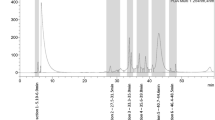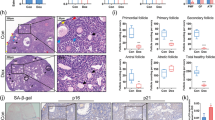Summary
This study examined the effects of ursolic acid (UA) on the proliferation and apoptosis of a human ovarian cancer cell line, CAOV3. The CAOV3 cells were cultured in the RPMI 1640 media and treated with different concentrations of UA (0, 10, 20, 40 μmol/L). The proliferation rate of the CAOV3 cells was determined by MTT assay. The apoptosis rate was measured by flow cytometry. ERK activity was detected by immunoprecipitation and the expressions of p-ERK1/2, MKP-1, Bax and Bcl-2 by Western blotting. The results showed that the proliferation rate was significantly decreased in the cells treated with UA as compared with that in the non-treated cells (P<0.05). The intracellular ERK activity and p-ERK1/2 expression were also reduced in the UA-treated cells, while the MKP-1 expression was elevated. Moreover, the apoptosis was found in the CAOV3 cells exposed to UA; the Bax expression was increased and the Bcl-2 expression decreased. The apoptosis rate in the UA-treated cells was much higher than that in the non-treated cells (P<0.05). It is concluded that UA can inhibit the proliferation of CAOV3 cells by suppressing the ERK activity and the expression of p-ERK1/2. And it can also induce the apoptosis of the CAOV3 cells by up-regulating the Bax expression and down-regulating the Bcl-2 expression.
Similar content being viewed by others
References
Liu J. Oleanolic acid and ursolic acid: research perspectives. J Ethnopharmacol, 2005,100(1–2):92–94
Liu J. Pharmacology of oleanolic acid and ursolic acid. J Ethnopharmacol, 1995,49(2):57–68
Hsu YL, Kuo PL, Lin CC. Proliferative inhibition, cell cycle dysregulation, and induction of apoptosis by ursolic acid in human non-small cell lung cancer A549 cells. Life Sci, 2004,75(19):2303–2316
Hollosv F, Ldei M, Csorba G, et al. Activation of cas pase-3 protease during the process of ursolic acid and its derivativeinduced apoptosis. Anticancer Res, 2001, 21(5):3485–3491
Zhang YY, Deng T, Hu ZF, et al. Mechanisms of inhibiting proliferation and inducing apoptosis of human gastric cancer cell line SGC7901 by ursolic acid. Chin J Cancer (Chinese), 2006,25(4):432–437
Tan J, Shen ZX, Geng W. Ursolic acid induces apoptosis in colon cancer HT-29 cells. Chin J Oncol (Chinese), 2006,28(2):99–102
Johnson GL, Lapadat R. Mitogen-activated protein kinase pathways mediated by ERK, JNK, and p38 protein kinases. Science, 2002,298(5600):1911–1912
Jin Y, Hu J, Wang Q, et al. Effects of oxymatrine on the apoptosis of human esophageal carcinoma Eca109 cell line and its mechanism. J Huazhong Univ Sci Technol [Med Sci], 2008,28(3):314–316
Andresen BT, Rizzo MA, Shome K, et al. The role of phosphatidic acidin the regulation of the Ras/MEK/Erk signaling cascade. FEBS Lett, 2002, 531(1):65–68
Webb CP, von Aelst L, Wigler MH, et al. Signaling pathways in Ras-mediated tumorigenicity and metastasis. Proc Natl Acad Sci, 1998,95(15):8773–8778
Harmand PO, Duval R, Delage C, et al. Ursolic acid induces apoptosis through mitochondrial intrinsic pathway and caspase-3 activation in M4Beu melanoma cells. Int J Cancer, 2005,114(1):1–11
Duval RE, Harmand PO, Jayat-Vignoles C, et al. Differential involvement of mitochondria during ursolic acid-induced apoptotic process in HaCaT and M4Beu cells. Oncol Rep, 2008,19(1):145–149
Kassi E, Sourlingas TG, Spiliotaki M, et al. Ursolic acid triggers apoptosis and Bcl-2 downregulation in MCF-7 breast cancer cells. Cancer Invest, 2009, 27(7):723–733
Tang C, Lu YH, Xie JH, et al. Downregulation of survivin and activation of caspase-3 through the PI3K/Akt pathway in ursolic acid-induced HepG2 cell apoptosis. Anticancer Drugs, 2009,20(4):249–258
Meng YQ, Liu D, Cai LL, et al. The synthesis of ursolic acid derivatives with cytotoxic activity and the investigation of their preliminary mechanism of action. Bioorg Med Chem, 2009,17(2):848–854
Huang HC, Huang CY, Lin-Shiau SY, et al. Ursolic acid inhibits IL-1beta or TNF-alpha-induced C6 glioma invasion through suppressing the association ZIP/p62 with PKC-zeta and downregulating the MMP-9 expression. Mol Carcinog, 2009,48(6):517–531
Lu S, Zhang B, Wang Z. Expression of survivin, cyclinD1, p21(WAF1), caspase-3 in cervical cancer and its relation with prognosis. J Huazhong Univ Sci Technol [Med Sci], 2005,25(1):78–81
Lu X, Yi J. SUMO-1 enhancing the p53-induced HepG2 cell apoptosis. J Huazhong Univ Sci Technol [Med Sci], 2005,25(3):289–291
Idogawa M, Sasaki Y, Suzuki H, et al. A single recombinant adenovirus expressing p53 and p21-targeting artificial microRNAs efficiently induces apoptosis in human cancer cells. Clin Cancer Res, 2009,15(11):3725–3732
Grinkevich VV, Nikulenkov F, Shi Y, et al. Ablation of key oncogenic pathways by RITA-reactivated p53 is required for efficient apoptosis. Cancer Cell, 2009,15(5): 441–453
Kepp O, Tesniere A, Zitvogel L, et al. The immunogenicity of tumor cell death. Curr Opin Oncol, 2009, 21(1):71–76
Wang J, Xiao B, Zheng J, et al. The effect of targeted magnetic nanopaticles on hepatoma and the expression of bcl-2/bax protein. J Huazhong Univ Sci Technolog [Med Sci], 2008,28(4):443–446
Heath-Engel HM, Chang NC, Shore GC. The endoplasmic reticulum in apoptosis and autophagy: role of the BCL-2 protein family. Oncogene, 2008,27(50):6419–6433
Yip KW, Reed JC. Bcl-2 family proteins and cancer. Oncogene, 2008,27(50):6398–6406
Author information
Authors and Affiliations
Corresponding author
Rights and permissions
About this article
Cite this article
Wang, X., Li, L., Wang, B. et al. Effects of ursolic acid on the proliferation and apoptosis of human ovarian cancer cells. J. Huazhong Univ. Sci. Technol. [Med. Sci.] 29, 761–764 (2009). https://doi.org/10.1007/s11596-009-0618-y
Received:
Published:
Issue Date:
DOI: https://doi.org/10.1007/s11596-009-0618-y




